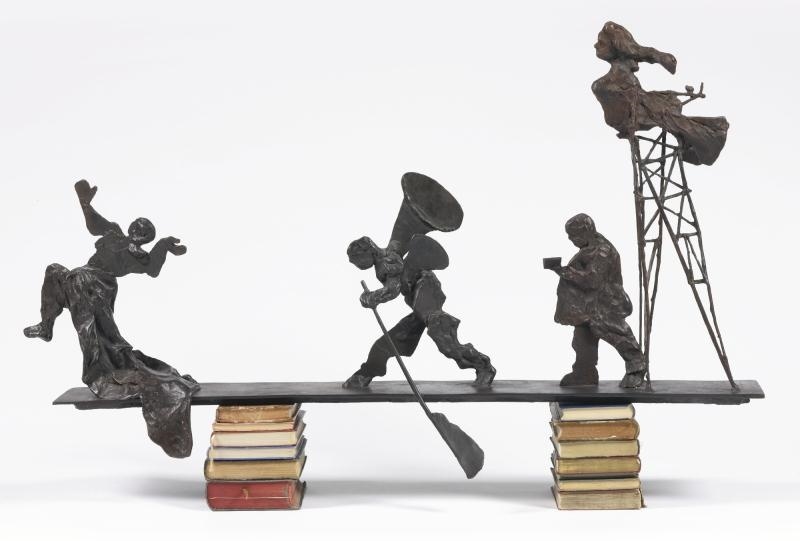William Kentridge

“A lot of the early work that I did had to do with either silhouettes or shadows,” Kentridge says of his first experiments with sculpture. “And shadows by their nature are immaterial, simply an absence of light, a blockage of the light. The sculptures started as a way of making this immaterial substance, or void, a shadow, into a solid, weighty material object.” Four Figures on a Bridge is one such filling out of absence, the solidifying of shadow into a three-dimensional form. Balanced across two piles of books, the work’s figures walk in strange procession. Such parades, both static and moving, recur across Kentridge’s work. Described variously as ‘’melancholy carnivals’’ and ‘‘historical pageants,’’ they are in turns triumphant, defeated and foreboding. Such relentless marches appear in Kentridge’s eight-channel video installation More Sweetly Play the Dance (2017) and his theatre performance The Head and the Load (2018). As ever, the figures are seen in silhouette, and many hold strange objects above their heads as both symbol and burden.
Four Figures on a Bridge is an editioned maquette for a public sculpture in Johannesburg, South Africa. In the full-scale work, the figures are larger than life and stand on a bridge eight metres above the ground.
b.1955, Johannesburg
Performing the character of the artist working on the stage (in the world) of the studio, William Kentridge centres art-making as primary action, preoccupation, and plot. Appearing across mediums as his own best actor, he draws an autobiography in walks across pages of notebooks, megaphones shouting poetry as propaganda, making a song and dance in his studio as chief conjuror in a creative play. Looking at his work, a ceaseless output and extraordinary contribution to the South African cultural landscape, one finds a repetition of people, places and histories: the city of Johannesburg, a white stinkwood tree in the garden of his childhood home (one of two planted when he was nine years old), his father (Sir Sydney Kentridge) and mother (Felicia Kentridge), both of whom contributed greatly to the dissolution of apartheid as lawyers and activists. The Kentridge home, where the artist still lives today, was populated in his childhood by his parents’ artist friends and political collaborators, a milieu that proved formative in his ongoing engagement with world histories of expansionism and oppression throughout the 20th century. Parallel to – or rather, entangled with – these reflections is an enquiry into art historical movements, particularly those that press language to unexpected ends, such as Dada, Constructivism and Surrealism.
Moving dextrously from the particular and personal to the global political terrain, Kentridge returns to metabolise these findings in the working home of the artist’s studio, where the practitioner is staged as a public figure making visible his modes of investigation. Celebrated as a leading artist of the 21st century, Kentridge is the artistic director of operas and orchestras, from Sydney to London to Paris to New York to Cape Town, known for his collaborative way of working that prioritises thinking together with fellow practitioners skilled in their disciplines (for example, as composers, as dancers). Most often, he is someone who draws, in charcoal, in pencil and pencil crayon, in ink, the gestures and mark-making assured. In a collection of books for which A4 acted as custodian during the exhibition History on One Leg, one finds 200 publications devoted to Kentridge’s practice. In the end, he has said, the work that emerges is who you are.